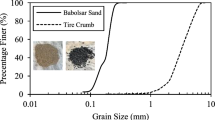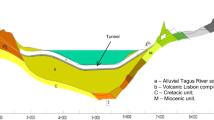Abstract
The paper presents a numerical simulation of stress-controlled undrained cyclic tri-axial tests conducted on local sand at various relative densities and CSR values. Two constitutive models for liquefaction, namely, Finn-Byrne model and PM4 sand model are used for the simulation. The results from both the material models are compared with the cyclic test results in terms of the stress strain loops, excess pore pressure ratio, and effective stress path. The chosen models have shown good predicting capabilities for predicting cyclic responses of a sand in terms of stress path and pore water pressure generation but lacks in predicting the stress strain behavior. Also, in terms of simulating the behavior of sand in pre- and post-liquefaction regime, it is found that PM4 sand model is more efficient than Finn model for all the relative densities. Hence, it is recommended that Finn model may be only utilized when a sand fails due to flow liquefaction, whereas PM4 sand model can predict both, flow liquefaction and cyclic mobility, accurately. Finally, the liquefaction resistance curves for different relative densities are obtained using experimental values and PM4 sand model. These curves are thus proposed for any sand with index properties similar to the particular sand considered for the study.



modified from Omidvar et al. 2012) during cyclic loading for 60% RD with CSR value of 0.23










Similar content being viewed by others
Availability of data and material
All the experimental data and the numerical simulations that support the findings of this study are available from the corresponding author upon reasonable request.
Code availability
The numerical simulations as a part of this study were performed in FLAC 2D and MIDAS GTS NX.
References
Anderson KH, Schjetne K (2013) Database of friction angles of sand and consolidation characteristics of sand, sit, and clay. Journal of Geotechnical and Geoenvironmental Engineering ASCE 139(7):1140–1155
Arulanandan K, Scott RF (1993) Verification of numerical procedures for the analysis of soil liquefaction problems. Vol. 1: experimental results and numerical predictions. Int. Conf. on the Verification of Numerical Procedures for the Analysis of Soil Liquefaction Problems. Rotterdam, Netherlands: A.A. Balkema.
Arulanandan K, Scott RF (1994) Verification of numerical procedures for the analysis of soil liquefaction problems. Vol. 2: experimental results and numerical predictions. Int. Conf. on the Verification of Numerical Procedures for the Analysis of Soil Liquefaction Problems. Rotterdam, Netherlands: A.A. Balkema.
ASTM D5311 (2011) Test method for load controlled cyclic triaxial strength of soil. Annual book of ASTM standards, ASTM International West Conhohocken PA.
Aubry D, Hujeux JC, Lassoudiere F, Meimon Y (1982) A double memory model with multiple mechanisms for cyclic soil behavior. Int. Symp. on Num. Models in Geomechanics, Zurich, (ed) R. Dungar, G. N. Pande and J. A. Studcr. Balkerna, Rotterdam.
Beaty M, Byrne PM (1998) An effective stress model for predicting liquefaction behavior of sand. Proceedings of a specialty conference, Geotechnical Earthquake Engineering and Soil Dynamics ASCE 766–777
Beaty MH (2018) Application of UBCSAND to the LEAP centrifuge experiments. Soil Dyn Earthq Eng 104:143–153
Biot MA (1962) Mechanics of deformation and acoustic propagation in porous media. J Appl Phys 33:1482–1498
Bishop AW (1973) The influence of an undrained change in stress on the pore pressure in porous media of low compressibility. Géotechnique 23(3):435–442
Bolton MD (1986) The strength and dilatancy of sands. Géotechnique 36:65–78
Boulanger RW (2003) High overburden stress effects in liquefaction analyses. Journal of Geotechnical and Geoenvironmental Engineering ASCE 129(12):1071–1082
Boulanger RW, Idriss IM (2014) CPT and SPT based liquefaction triggering procedures. Davis, CA: Center for Geotechnical Modeling, Department of Civil andEnvironmental Engineering, University of California; Report No. UCD/CGM-14/01
Budhu M (2011) Soil mechanics and foundation, 3rd edn. John Wiley & Sons Inc, Hoboken
Byrne PM (1991) A cyclic shear-volume coupling and pore pressure model for sand. Proceeding of Second International Conference on Recent Advances in Geotechnical Earthquake Engineering and Soil Dynamics 1:47–55
Carey TJ, Kutter BL (2017) Comparison of liquefaction constitutive models for a hypothetical sand. Geotechnical Front (GSP 281)
Chattaraj R, Sengupta A (2016) Liquefaction potential and strain dependent dynamic properties of Kasai River sand.Soil Dyn. Earthq Eng 90:467–475
Chen L, Ghofrani A, Arduino P (2020) Prediction of LEAP-UCD-2017 centrifuge test results using two advanced plasticity sand models. In: Kutter B., Manzari M., Zeghal M. (ed) Model Tests and Numerical Simulations of Liquefaction and Lateral Spreading. Springer.
Chiaradonna A, Tropeano G, d’Onofrio A, Silvestrim F (2018) Development of a simplified model for pore water pressure build-up induced by cyclic loading. Bull Earthq Eng 16(9):3627–3652
Dafalias YF, Manzari MT (2004) Simple plasticity sand model accounting for fabric change effects. J Engg Mech ASCE 130(6): 622–634
Dawson EM, Mejia LH (2012) Updates to a practice-oriented liquefaction model. GeoCongress; ASCE 2118–2127
ElgamalA YZ, Parra E (2002) Computational modeling of cyclic mobility and post-liquefaction site response. Soil Dyn Earthq Eng 22(4):259–271
Eslami MM, Zarrabi M, Yniesta S(2019) Evaluation of two constitutive models in predicting the cyclic behavior of a natural clay. 7th Int Conf Earthq Geotechnical Eng 2275–2282
Finn WLD, Lee KW, Martin GR (1977) An effective stress model for liquefaction. J Geotech Eng Div ASCE. https://doi.org/10.1061/AJGEB6.0000434
Ghaboussi J, Dikmen SU (1978) Liquefaction analysis of horizontally layered sands. J Geotech Eng Div ASCE 104(GT3): 341–356
Hyodo M, Hyde AFL, Aramaki N (1998) Liquefaction of crushable soils.Geotechnique 48(4): 527–543
Itasca Consulting Group, FLAC (2005) Fast Lagrangian analysis of continua in 2-dimensions 5.0, manual. Itasca, Minneapolis.
Jefferies M, Been K (2015) Soil liquefaction: a critical state approach. CRC Press
Kramer SL (2005) Geotechnical earthquake engineering.Prentice hall, Upper Saddle River, NJ.
Kutter BL, Carey TJ et al (2015) LEAP database for verification, validation, and calibration of codes for simulation of liquefaction. In Proc., 6th Int Conf Earthq Geotechnical Eng. Christchurch, New Zealand.
Lombardi D, Bhattacharya S, Hyodo M, Kaneko T (2014) Undrained behavior of two silica sands and practical implications for modelling SSI in liquefiable soils. Soil Dyn Earthq Eng 66:293–304
Manzari MT, Dafalias YF (1997) A critical state two-surface plasticity model for sands. Géotechnique 47(2): 255–272
MIDAS G (2019) GTS NX User Manual.
Mroz M (1967) On the description of anisotropic work-hardening. J Mech Phys Solids 15:163–175
Omidvar M, Iskander M, Bless S (2012) Stress-strain behavior of sand at high strain rates. Int J Impact Eng 49:192–213
Parra E (1996) Numerical modeling of liquefaction and lateral ground deformation including cyclic mobility and dilation response in soil system. Dissertation, Rensselaer Polytechnic Institute.
Prevost JH (1985) A simple plasticity theory for frictional cohesionless soils. Soil Dyn Earthq Eng 4(1):9–17
Rad NS, Clough WG (1982) The influence of cementation on the static and dynamicbehavior of sands. The John A. Blume Earthquake Engineering Center, Stanford Univ., Report No, Stanford, California, p 59
Ramirez J, Barrero AR, Chen L, Dashti S, Ghofrani A, Taiebat M, Arduino P (2018) Site response in a layered liquefiable deposit: evaluation of different numerical tools and methodologies with centrifuge experimental results. J Geotechnical Geoenvironmental Eng ASCE 144(10): 04018073
Shou KJ, Wang CF (2003) Analysis of the Chiufengershan landslide triggered by the 1999 Chi-Chi earthquake in Taiwan. Eng Geol 68(3):237–250
Skempton A (1954) The pore-pressure coefficients A and B. Geotechnique 4:143–147
Sriskandakumar S (2004) Cyclic loading response of Fraser Riversand for validation of numerical models simulating centrifuge tests. Dissertation, University of British Columbia.
Stark TD, Contreras IA (1998) Fourth Avenue landslide during 1964 Alaskan earthquake. Journal of Geotechnical and Geoenvironmental Engineering ASCE 124(2):99–109
Tasiopoulou P, Gerolymos N (2016) Constitutive modeling of sand: formulation of a new plasticity approach. Soil Dyn Earthq Eng 82:205–221
Thomas J (1992) Static, cyclic and post liquefaction undrained behavior of Fraser River sand. Dissertation, University of British Columbia.
Wu W, Bauer E, Kolymbas D (1996) Hypoplastic constitutive model with critical state for granular materials. Mech Mater 23(1): 45–69
Xenaki VC, Athanasopoulos GA (2003) Liquefaction resistance of sand-mixtures: an experimental investigation of the effect of fines.Soil Dyn. Earthq Eng 23:183–194
Yang M, Seidalinov G, Taiebat M (2018) Multidirectional cyclic shearing of clays and sands: Evaluation of two bounding surface plasticity models. Soil Dyn Earthq Eng 124:230–258
Yang Z, Elgamal A, Parra E (2003) Computational model for cyclic mobility and associated shear deformation. J Geotechnical Geoenvironmental Eng ASCE 129(12): 1119–1127
Zarrabi M, Yniesta S (2019) Recent Advanced Constitutive Models for Liquefaction and Cyclic Softening Analysis.72nd Canadian Geotechnical Conference, At: St. John's, Newfoundland and Labrador, Canada.
Zhang JM, Wang G (2012) Large post-liquefaction deformation of sand, part I: physical mechanism, constitutive description and numerical algorithm. Acta Geotech 7(2):69–113
Zhu Z, Zhang F, Peng Q, Dupla JC, Canou J, Cumunel G, Foerster E (2021) Effect of the loading frequency on the sand liquefaction behaviour in cyclic triaxial tests. Soil Dyn Earthq Eng 147: 106779
Zienkiewicz OC, Chang CT, Hinton E (1978) Non-linear seismic response and liquefaction. Int J Numer Anal Meth Geomech 2:381–404
Ziotopoulou K (2018) Seismic response of liquefiable sloping ground: class A and C numerical predictions of centrifuge model responses. Soil Dyn Earthq Eng 113:744–757
Ziotopoulou K, Boulanger RW (2013) Calibration and implementation of a sand plasticity plane-strain model for earthquake engineering application. Soil Dyn Earthq Eng 53:268–280
Acknowledgements
The authors’ work was benefitted from the electronic discussions held with Associate Prof. Nikos Gerolymos at National Technical University of Athens. The authors of the paper would also like to thank the reviewers for their time and for the thought provoking comments which helped to improve the quality of the work.
Funding
Fellowship received from Bhabha Atomic Research Centre, Mumbai, for the first author during Masters (M. Tech) at IIT Kharagpur.
Author information
Authors and Affiliations
Contributions
All the authors contributed to the study. The experiments were performed by Rana Chattaraj (as a part of his Ph.D. work) and Raj Banerjee (as a part of his M. Tech work) under the guidance and supervision of Prof. Aniruddha Sengupta which was validated numerically in the present study. The first draft of the manuscript was written by Raj Banerjee and Dr. Yogita Parulekar, and the authors commented on previous versions of the manuscript. All the authors read and approved the final manuscript.
Corresponding author
Ethics declarations
Competing interests
The authors declare no known competing interests.
Rights and permissions
About this article
Cite this article
Banerjee, R., Chattaraj, R., Parulekar, Y.M. et al. Numerical prediction of undrained cyclic triaxial experiments on saturated Kasai river sand using two constitutive models of liquefaction. Bull Eng Geol Environ 80, 8565–8582 (2021). https://doi.org/10.1007/s10064-021-02449-2
Received:
Accepted:
Published:
Issue Date:
DOI: https://doi.org/10.1007/s10064-021-02449-2




